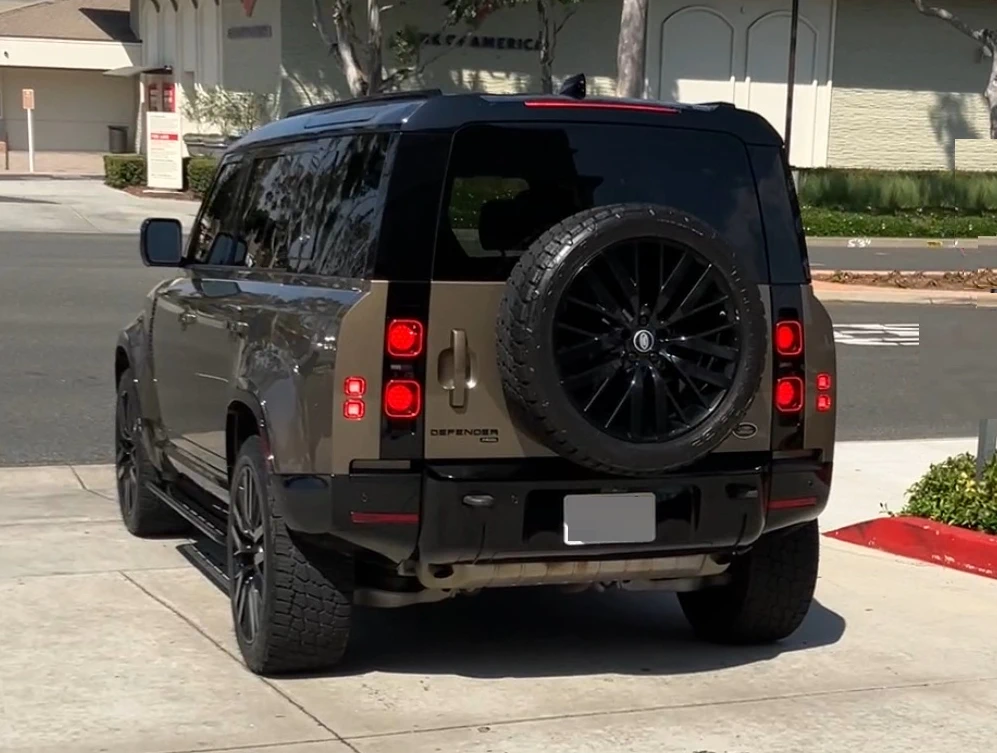The reborn Defender family keeps the brand’s off-road ethos but packages it three ways: the compact, two-door 90; the five-door, do-everything 110; and the stretched 130 with true three-row space. All ride on a modern platform with permanent four-wheel drive, available air suspension, Terrain Response drive modes, and the latest Pivi Pro infotainment, then layer in different bodies, seating layouts, and powertrains to suit the mission.
Defender 90: short wheelbase, big personality
The 90 is the most agile of the trio and embraces the classic two-door silhouette. Current U.S. positioning highlights a V8 variant with up to 518 hp and 0–60 mph as quick as 4.9 seconds, plus a towing rating up to 8,200 lbs when properly equipped. Inside, it seats up to five and can be fitted with the 13.1-inch Pivi Pro touchscreen. If the brief is “weekend trails and city parking,” the 90’s tight turning circle and short overhangs are the point. (Land Rover)
Defender 110: the sweet-spot five-door
The 110 adds rear doors, a longer wheelbase, and the most configuration flexibility. It’s the Defender many families choose because it balances daily comfort with expedition prowess, and it can be ordered with an optional third row for up to seven seats. The 110 also spans the widest powertrain and trim range—including comfort-leaning models for road trips and specialized off-road builds—so it’s easy to tailor to commuting, camping, or both. (Land Rover)

Defender 130: three rows and long-haul range
Need true adult-friendly third-row space and luggage room? The 130 stretches the 110’s body for seating up to eight and a cargo hold that can reach a quoted 89 cu ft (wet) with seats folded. Yet it still delivers Defender fundamentals: up to 11.5 inches of ground clearance and the same suite of off-road aids, with available V8 power for confident highway passing when loaded with passengers and gear. (Land Rover)
Off-road bona fides (the shared DNA)
Across the lineup, geometry and hardware are what make a Defender feel like a Defender. Maximum wading depth on core models is listed up to 35.4 inches (model-dependent), and ground clearance on long-body variants approaches the 11.5-inch mark. Air suspension, locking differentials, All-Terrain Progress Control, and configurable Terrain Response help translate specs into confidence on steep, rutted, or slick surfaces. For those chasing ultimate numbers, the new DEFENDER OCTA variant raises the bar further with a quoted wading depth of up to 3.3 feet.
Cabin tech and materials
Pivi Pro brings a crisp interface, fast responses, and over-the-air updates, presented on a large central touchscreen (up to 13.1 inches on current models). The interior favors hard-wearing surfaces and open-pore finishes, with plenty of charging points and configurable storage; step up the range for richer leathers, heated/ventilated seating, and premium Meridian audio. The result is a cabin equally happy wearing trail dust or dress clothes.
Towing and carrying
Even the compact 90 can be rated to tow up to 8,200 lbs, with camera-based aids (including available Advanced Tow Assist) to simplify hitching and backing. Roof-load guidance varies by model and wheel/tire fitment, but the family is set up for racks, boxes, and expedition accessories—just check dynamic vs. static load limits in the spec pages when planning rooftop tents or heavier kits.
Powertrains at a glance
Lineup specifics vary by model year and trim, but today’s Defenders span from smooth six-cylinder mild-hybrids to supercharged V8s, with the 90 prominently featuring a 518-hp V8 configuration and the 130 offering a 493-hp V8 among its choices. The 110 range is the broadest, and special variants like OCTA introduce higher-output V8 hardware and upgraded cooling, suspension, and driveline components. Always confirm regional/trim availability when building.
Which Defender fits what mission?
Choose the 90 if tight trails, smaller garages, and maximum character per inch are priorities; it’s the most maneuverable and the quickest-feeling. Pick the 110 if versatility is the brief—commuting Monday, gravel switchbacks Saturday—especially if an optional third row is appealing. Opt for the 130 if three-row comfort is non-negotiable and long-distance road trips with a full crew are on the calendar; it’s the one that lets eight people and their bags come along without leaving Defender capability on the table.
Bottom line
All three are unmistakably Defender: upright stance, purposeful detailing, and serious all-terrain chops. The 90 is the compact icon, the 110 the do-everything core model, and the 130 the space-efficient hauler that doesn’t abandon the trail for the third row. Decide by seats, cargo, and where the odometer will spend its miles—then build accordingly.
